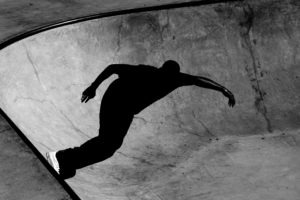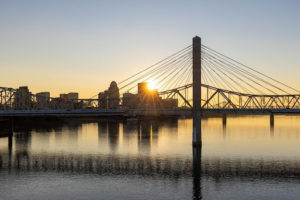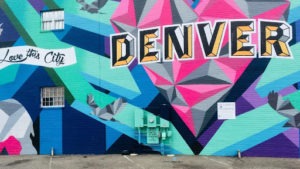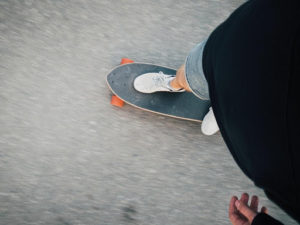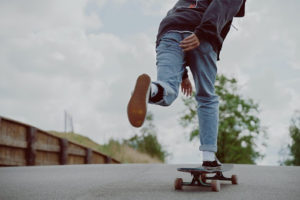When you’re new to skateboarding, starting out can be an exciting yet overwhelming time. It’s important to have the proper attire, gear, and safety equipment to ensure a safe and enjoyable experience for everyone. To help you get started, we’ve put together this beginner’s checklist of necessary skateboarding gear.
Proper Skating Attire
To put it simply, comfort beats style. It may be tempting to “dress the part” and opt for looks over function, but generally speaking, you should wear whatever feels comfortable for you. Your clothing should provide a reasonable degree of flexibility. You should be able to twist, turn, and raise your arms comfortably. As a word of warning, we recommend avoiding loose fitting pants and shoes with long laces as they can get caught in the wheels.
Skateboarding is a sport, so expect to sweat!
- Try to opt for shirts made from cotton or other moisture-wicking materials.
- Pants should be durable enough to provide some sort of protection from cement.
- Don’t underestimate the value of a high-quality sock. Cotton socks can quickly get gross while skating due to their inability to dry easily once wet. Make sure to choose socks made from moisture-wicking materials such as merino wool. Additionally, it’s a good idea to ensure your socks fit properly and can stay up without rolling down to your ankles.
Skate Shoes
We don’t recommend going out to skate with just any pair of tennis shoes or sneakers you have lying around. Skate shoes are built to be more durable, lightweight, and lower profile than the average sneaker, which is necessary as your shoe will come into contact with rough surfaces such as cement, metal, and the grip tape on your skateboard, to help promote better board feel.
Skate shoes are optimized for skating conditions, including the following features:
- A flat sole made from polyurethane or rubber to help grip the board cushion hard landings
- Heavy-duty fabrics such as canvas, suede, and leather
- More impact-resistant materials such as STI foam
- A low profile to make tricks easier to perform and help the rider better feel the deck
Safety Equipment
Helmet
Never go skateboarding without a proper fitting helmet, period (even if you see famous athletes riding without one). Many skate parks now require all riders to wear helmets.
The right helmet can help protect you from concussions and other head injuries, and without sounding too dramatic, could possibly save your life. Don’t skimp and buy whatever helmet is cheapest. While you don’t have to splurge, remember that a good helmet is an investment, and a necessary one.
Padding and Guards
Additional protective gear such as extra padding and guards is highly recommended for skateboarders who are just starting out and gaining their balance on the board. Knee pads are especially recommended as knee injuries are some of the most common in skating.
When you’re a beginner, the elbows can be very vulnerable to skate related injury, especially if you’re still learning how to properly fall. Depending on the style, some elbow pads may restrict movement. Try to find styles that aren’t too bulky and fit properly.
Wrist braces and guards can also be helpful for beginners, but they shouldn’t encourage you to use your hands to break your fall.
Skateboard
Now that we’ve covered attire and protective gear, we’ve come to the fun part. When it comes to buying your board, you usually have two options: buying a complete or buying the individual components and building the board yourself, or having a local shop build it for you.
Complete Skateboards
Broadly speaking, we recommend getting a complete skateboard when you’re first starting out. These pre-assembled options tend to be more budget friendly and allow you to get started quickly as opposed to having to build out your board first, which can seem intimidating.
You always have the option to slowly upgrade if you go the complete route.
Components
Another option is to custom build your skateboard from individual components. While we don’t generally recommend this DIY approach for complete beginners without the guidance of knowledgeable sales personnel, we wouldn’t necessarily discourage it as it can be done with a little patience and practice.
If you’re building out your skateboard, broadly, you’ll need the following components (and a few other accessories and tools):
A Safe Place to Skate
We’ve covered attire, safety gear, and the skateboard itself. The next thing you need is a safe skating environment. Having a safe place to skate is just as important as having all of the proper equipment.
Always mind the weather. If the ground is wet, it’s best to postpone.
If possible, try to find a recognized skate park in your area. This ensures that the surfaces you’re riding are fit for skating. If there are no skate parks near you, there are some areas that tend to work well. Avoid private property and always be sure to check for any posted signs with rules and regulations to avoid trespassing:
- A park
- Your neighborhood
- An empty parking lot
Now that you’ve gone over out beginner’s checklist of skateboarding necessities, it’s time to find the gear that’s right for you and get out there!


